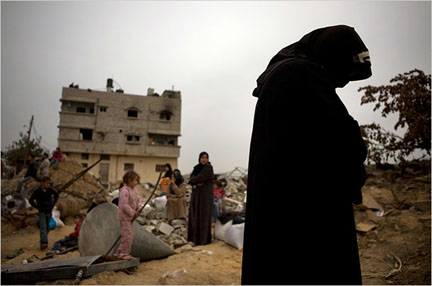
Residents returned to their homes around Gaza City on Friday. Tyler Hicks/The New York Times
Gaza is not history, nor is it likely to be soon. The bombs may have ceased on both sides, but the human toll presages a bleak future. Both sides have grievances, but the grief from death, maiming and sheer destruction of property and homes is incredibly disproportional. Even Independent observers must acknowlege this:
Up to 10 times as many Palestinians were killed as Israelis. The Palestinian Ministry of Health says 1,314 Palestinians were killed, of whom 412 were children or teenagers under 18, and 110 were women. On the Israeli side, there were 13 deaths between 27 December and 17 January, of whom three were civilians killed by rockets fired from Gaza. Of the 10 soldiers killed, four were lost to “friendly fire”.
Even if the Palestinian figure is disputed, it is clear that the death toll was massively higher for Palestinians than Israelis. Proportionality is not simply a matter of numbers, however. There will also be a debate over whether the destruction wrought by Israel’s huge land, sea and air arsenal was proportionate to the threat posed by Hamas militants to civilians – itself also a violation of international humanitarian law.
This is not just a case of using a shotgun to kill a bee to avoid being stung. The Palestinians who attempt to live in Gaza are literally confined to a virtual hell on earth. When they are not boxed in all sides by a form of non-salutary cultural confinement, they are treated as less than human at any border crossing. The focus on blaming Hamas deflects the reason that an organization like Hamas could evolve in the first place. To argue that Gazan children are born hating Israel is absurd, not unlike the sentiment of some Western pioneers that the only good Indian was a dead Indian. The 400 or so children and teens who were killed in the 22 days of Israeli attacks are victims of an unresolved adult hatefest. The manner of their deaths ensures that there will be many more to come on both sides.
These are not the good old hallelujah Yahweh days, when prophets would foam at the mouth about the destruction of the Assyrians and Babylonians, warning of coming payback for the enemies of Israel. Those days probably never existed in the first place, although the ideology of biblical eye-for-eye justice in the eyes of a jealous all-or-nothing God has hardly abated. Adding yet more words to this tragedy may soothe my own feelings, but what more needs to be said? No matter what you feel about the recent suffering, if you want to see a visual version of how disproportionate it was, check out the dual photo essay in today’s New York Times by two photographers, Moises Saman inside Israel and Tyler Hicks inside Gaza. When words fail, as they must in this case, pictures at least can jolt us into recognizing that the scale of suffering is not about getting even, but getting over it.